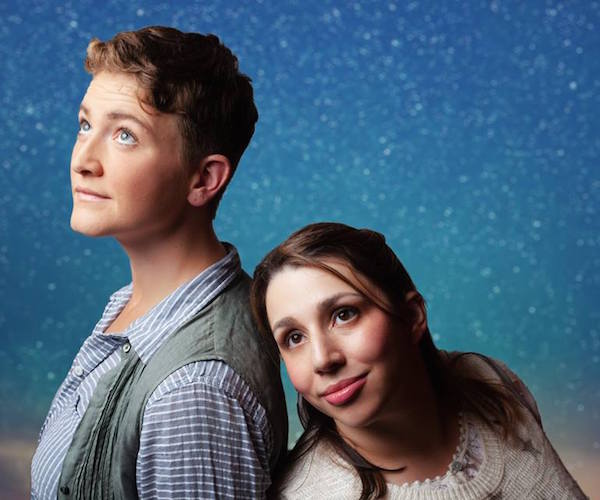Theater Review: “Peter and the Starcatcher” — A Theatrical Adventure
Hub Theatre Company’s production bursts with energy, staged with a clear-minded sense of movement and a handmade quality that generates ample charm and whimsy.
Peter and the Starcatcher, text by Rick Elice, music by Wayner Barker. Directed by Sarah Gazdowicz. Staged by Hub Theatre Company of Boston at the First Church Boston, 66 Marlborough Street, Boston, MA, through November 17.

Claire Koenig and Lauren Elias in the Hub Theatre Company production of “Peter and the Starcatcher.” Photo: Courtesy of HUB Theatre Company.
By Erik Nikander
The finale to Hub Theatre Company’s 2018 season is Rick Elice’s Peter and the Starcatcher, a family-friendly semi-musical extravaganza. Based on the novel by Dave Barry and Ridley Pearson (which is itself a prequel to J.M. Barrie’s Peter Pan stories), the play is a swashbuckling, piratical adventure yarn that overflows with nautical silliness. It leans heavily on the audience’s shared cultural understanding of Peter Pan; sometimes this works in the play’s favor, but on occasion become a distraction. Regardless, Hub’s production of the show is always bursting with energy, staged with a clear-minded sense of movement and a handmade quality that generates ample charm and whimsy.
Two ships set sail on a desperate mission. The first, the Wasp, carries Lord Aster (Liz Adams), an agent of Queen Victoria tasked with shepherding a trunk of precious cargo across the sea. Aster’s daughter Molly (Lauren Elias) is aboard the second ship, the Neverland, and she soon befriends three orphan boys, one of whom (Claire Koenig) does not even have a name. When the dread pirate Black Stache (Joey C. Pelletier) hijacks the Wasp — and finds that the treasure has been placed aboard the Neverland by accident — a wild chase ensues. Molly and the boys soon find themselves with the fate of the world in their hands.
Is it a spoiler to say that Claire Koenig’s nameless Boy becomes the legendary Peter Pan by the end of the play? This is clear by way of the play’s title, but also because Koenig imbues her character with such a defiant and mischievous spirit. Her Peter never feels or does anything halfway; he is overwhelmed by orphanhood’s loss and abandonment and filled with joy when he witnesses the magic unfolding around him. Koenig’s all-in emotional commitment to the part not only makes Peter compelling to watch, but it also ensures that he is believable as both an ordinary boy as well as Barrie’s embodiment of childhood wonder.
The rest of the ensemble cast is led by Lauren Elias as Molly Aster, the Starcatcher of the play’s title. Molly is a thirteen-year-old eager to prove she can live up to her father’s expectations. Elias gives her an appropriate balance of beyond-her-years wisdom and childlike trepidation. Pelletier gives by far the most delightfully campy turn as the flamboyant Black Stache. Sweeping across the stage in a demonic whirlwind, he’s an appropriately frightening villain who is clearly having the time of his wicked life. Liz Adams plays Lord Astor with bushels of Stiff Upper Lip courage, Bob Mussett is delightful as Mrs. Bumbrake, and Robert Orzalli steps seamlessly into a handful of crucial (and often hilarious) roles.
Director Sarah Gazdowicz deftly orchestrates these maritime misfits with an expert sense of movement and timing. Her playful staging choices, in which members of the ensemble step in to play creaking doors and support flying children endows the production with a pleasing low-tech craftiness. It is as if the show is being presented in a town square by a traveling theatre troupe. With the assistance of movement captain Michael John Ciszewski (who is also hilarious as Smee), the director does right by the high-tension chase scenes and pirate duels, often using little more than the shifting bodies of her actors and a few of Cesara Walters’s well-designed props.
The script itself is more inconsistent than the production. In general, its brand of high-spirited humor is quite successful, building off the original Peter Pan stories in many inventive ways. One issue that has plagued Peter Pan throughout the years is its use of stereotypical island natives as a story device, a controversy that reared its ugly head in recent years when the decidedly-white Rooney Mara was cast as Tiger Lily in the film Pan. Peter and the Starcatcher sidesteps the issue altogether by turning its “natives” into a band of disgruntled Italian chefs. This is a clever twist on the formula, surprising those familiar with the standard story and providing welcome splash of weirdness for newcomers.
In other areas, however, the play feels overly reliant on the audience’s knowledge of the original Peter Pan, especially in the second act. While the first section of the script is a compelling swashbuckler in its own right, the latter half is obsessed with setting up nearly every celebrated element from Peter Pan. It’s easy to see where these scenes are going, which makes the post-intermission sections of the play a bit draggy and repetitive. In addition, the script leans too heavy for this critic’s taste on anachronistic references to modern-day culture. These references are a little funny to begin with, but their returns diminish quickly, resulting in bits that are more annoying than amusing.
Of course, this isn’t a show meant for jaded theater critics. Peter and the Starcatcher’s real target audience are the kids who are brought to see it. And they are likely to be enraptured. Thanks to the gung-ho spirit and visual flair of Hub Theatre Company’s staging, their parents will probably enjoy the show just as much. The script is uneven at times, but the Hub-ers succeed at bringing J.M. Barrie’s sense of wonder to the theater.
Erik Nikander is a critic, playwright, and filmmaker based in the New England area. His film criticism can be read on Medium and his video reviews on a variety of topics can be viewed on Youtube at EWN Reviews.
